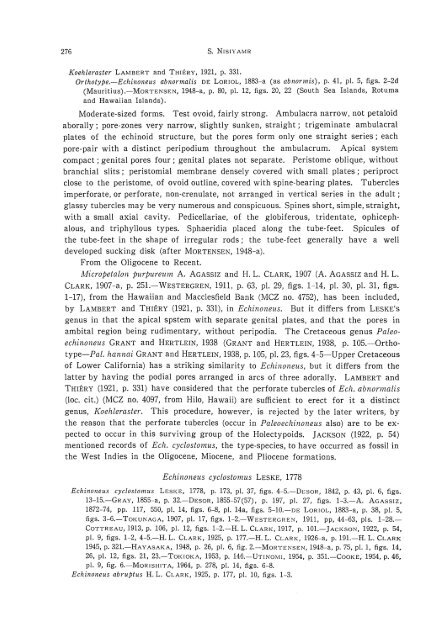the echinoid fauna from japan and adjacent regions part i
the echinoid fauna from japan and adjacent regions part i
the echinoid fauna from japan and adjacent regions part i
You also want an ePaper? Increase the reach of your titles
YUMPU automatically turns print PDFs into web optimized ePapers that Google loves.
276<br />
S. NISIYAMR<br />
Koehleraster LAMBERT <strong>and</strong> THIERY, 1921, p. 331.<br />
Orthotype.-Echinoneus abnormalis DE LORIOL, 1883-a (as abnormis), p. 41, pI. 5, figs. 2-2d<br />
(Mauritius).-MoRTENsEN, 1948-a, p. 80, pI. 12, figs. 20, 22 (South Sea Isl<strong>and</strong>s, Rotuma<br />
<strong>and</strong> Hawaiian Isl<strong>and</strong>s).<br />
Moderate-sized forms. Test ovoid, fairly strong. Ambulacra narrow, not petaloid<br />
aborally; pore-zones very narrow, slightly sunken, straight; trigeminate ambulacral<br />
plates of <strong>the</strong> <strong>echinoid</strong> structure, but <strong>the</strong> pores form only one straight series; each<br />
pore-pair with a distinct peripodium throughout <strong>the</strong> ambulacrum. Apical system<br />
compact; genital pores four; genital plates not separate. Peristome oblique, without<br />
branchial slits; peristomial membrane densely covered with small plates; periproct<br />
close to <strong>the</strong> peristome, of ovoid outline, covered with spine-bearing plates. Tubercles<br />
imperforate, or perforate, non-crenulate, not arranged in vertical series in <strong>the</strong> adult;<br />
glassy tubercles may be very numerous <strong>and</strong> conspicuous. Spines short, simple, straight,<br />
with a small axial cavity. Pedicellariae, of <strong>the</strong> globiferous, tridentate, ophicephalous,<br />
<strong>and</strong> triphyllous types. Sphaeridia placed along <strong>the</strong> tube-feet. Spicules of<br />
<strong>the</strong> tube-feet in <strong>the</strong> shape of irregular rods; <strong>the</strong> tube-feet generally have a well<br />
developed sucking disk (after MORTENSEN, 1948-a).<br />
From <strong>the</strong> Oligocene to Recent.<br />
Micropetalon pllrpllreum A. AGASSIZ <strong>and</strong> H. L. CLARK, 1907 (A. AGASSIZ <strong>and</strong> H. L.<br />
CLARK, 1907 -a, p. 251.-WESTERGREN, 1911, p. 63, pI. 29, figs. 1-14, pI. 30, pI. 31, figs.<br />
1-17), <strong>from</strong> <strong>the</strong> Hawaiian <strong>and</strong> Macclesfield Bank (MCl no. 4752), has been included,<br />
by LAMBERT <strong>and</strong> THIERY (1921, p. 331), in Echinonells. But it differs <strong>from</strong> LESKE'S<br />
genus in that <strong>the</strong> apical spstem with separate genital plates, <strong>and</strong> that <strong>the</strong> pores in<br />
ambital region being rudimentary, without peripodia. The Cretaceous genus PaleoechinoneliS<br />
GRANT <strong>and</strong> HERTLEIN, 1938 (GRANT <strong>and</strong> HERTLEIN, 1938, p. 105.-0rthotype-Pal.<br />
hannai GRANT <strong>and</strong> HERTLEIN, 1938, p. 105, pI. 23, figs. 4-5-Upper Cretaceous<br />
of Lower California) has a striking similarity to Echinoneus, but it differs <strong>from</strong> <strong>the</strong><br />
latter by having <strong>the</strong> podial pores arranged in arcs of three adorally. LAMBERT <strong>and</strong><br />
THIERY (1921, p. 331) have considered that <strong>the</strong> perforate tubercles of Ech. abnonnalis<br />
(loc. cit.) (MCl no. 4097, <strong>from</strong> Hilo, Hawaii) are sufficient to erect for it a distinct<br />
genus, Koehleraster. This procedure, however, is rejected by <strong>the</strong> later writers, by<br />
<strong>the</strong> reason that <strong>the</strong> perforate tubercles (occur in Paleoechinoneus also) are to be expected<br />
to occur in this surviving group of <strong>the</strong> Holectypoids. JACKSON (1922, p. 54)<br />
mentioned records of Ech. cyclOSt01nllS, <strong>the</strong> type-species, to have occurred as fossil in<br />
<strong>the</strong> West Indies in <strong>the</strong> Oligocene, Miocene, <strong>and</strong> Pliocene formations.<br />
Echinoneus cyclostomlls LESKE, 1778<br />
Echinoneus cyclostomus LESKE, 1778, p. 173, pI. 37, figs. 4-5.-DESOR, 1842, p. 43, pI. 6, figs.<br />
13-15.-GRAY, 1855-a, p. 32.-DESOR, 1855-57(57), p. 197, pI. 27, figs. 1-3.-A. AGASSIZ,<br />
1872-74, pp. 117, 550, pI. 14, figs. 6-8, pI. 14a, figs. 5-10.-DE LORIOL, 1883-a, p. 38, pI. 5,<br />
figs. 3-6.-TOKUNAGA, 1907, pI. 17, figs. 1-2.-WESTERGREN, 1911, pp, 44-63, pis. 1-28.<br />
COTTREAU, 1913, p. 106, pI. 12, figs. 1-2.-H. L. CLARK, 1917, p. 101.-JACKSON, 1922, p. 54,<br />
pI. 9, figs. 1-2, 4-5.-H. L. CLARK, 1925, p. 177.-H. L. CLARK, 1926-a, p. 191.-H. L. CLARK<br />
1945, p. 321.-HAY ASAKA, 1948, p. 26, pI. 6, fig. 2.-MoRTENSEN, 1948-a, p. 75, pI. 1, figs. 14,<br />
26, pI. 12, figs. 21, 23.-TOKIOKA, 1953, p. 146.-UTINOl\II, 1954, p. 351.-COOKE, 1954, p. 46,<br />
pI. 9, fig. 6.-MoRISHITA, 1964, p. 278, pI. 14, figs. 6-8.<br />
Echinoneus abruptus H. L. CLARK, 1925, p. 177, pI. 10, figs. 1-3.












